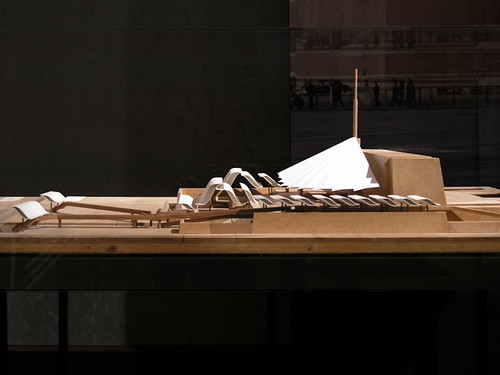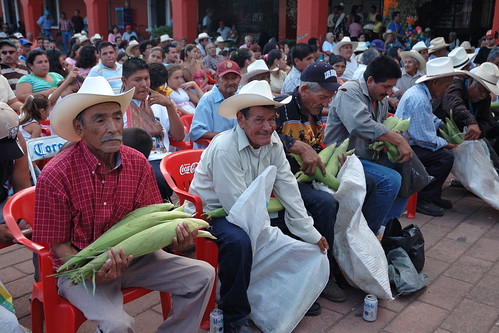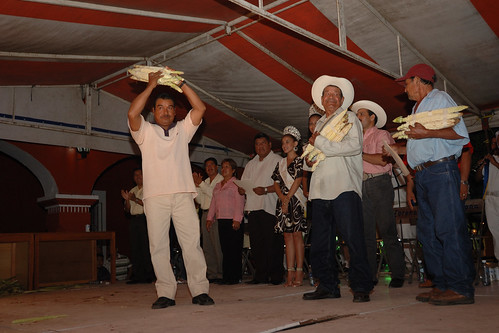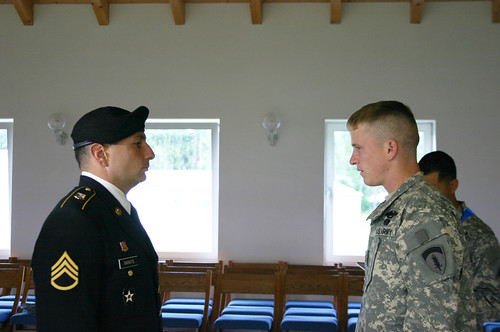jørn utzon, architect, madrid opera house, competition model 1964
Image by seier+seier
madrid opera house, competition model 1964.
from the 2008 utzon exhibition in palazzo franchetti, venice.
architect: jørn utzon, 1918-2008.
this photo was uploaded with a CC license and may be used free of charge and in any way you see fit.
if possible, please name photographer "SEIER+SEIER". if not, don't.
I was hoping to get away with just posting a photo of the madrid opera, comparing it with the church in bagsværd and not writing a word, but some very serious comments on the first photo made that impossible. so, here is a somewhat less successful shot of the whole model. and words.
the madrid project has an uncertain place in utzon's ouevre; he has never done much to publish it, and, in fact, I believe that my former boss, johan fogh, picked this very model out of utzon's rubbish, carried it home and had it repaired. it would appear we were not meant to see it.
it stems from the years utzon spent developing and building the opera house in sydney. construction had been initiated prematurely - for political reasons, obviously - yet utzon insisted on running a very small studio and taking his time, including the time to enter competitions like this one.
I can think of three with a program similar to that of sydney - zürich, wolfsburg and madrid - and in these utzon was clearly trying to figure out which way to go, following that heroic and, let us be frank, almost unbuildable effort. he won in zürich with a pragmatic project that didn't challenge conventional engineering much except for some long spans. unfortunately for zürich and utzon, the project was cancelled after several years.
I love how the books all say that the wolfsburg theatre won 4th prize. what they forget to mention is that only four architect were invited to the competition. utzon lost. the project is surprisingly insensitive to what we might call its cultural context. it developed the theme of the raised platform or bastion from the sydney opera house, digging it into a hillside in a way which underlined the military origin of the building type. the good people of wolfsburg, a town founded by the nazis, wisely chose hans scharoun's proposal which displayed a lightness of touch unusual for its architect.
and this brings us to madrid. the bastion is there as are the monumental stairs, recurring themes in utzon's work at the time. but look again: the bastion is hollow, suggesting a walled garden, an image confirmed by the planted areas in the plan. and what is it with those blind walls, slanted as if they were mudbrick constructions? or the folded-plate concrete roof suspended over the auditorium like a tent and the smaller, shading roofs surrounding it?
this is a modernist re-imagining of islamic architecture - and not its great legacy of civic buidings, but its most informal components: the blank walls, the gardens, the tents. the informality is followed up by utzon with asymmetrical patterns of movement, even inside the auditorium. if we play along, there is magic here. imagine a night under southern skies: the trees, the water, the floating roofs over a stepped garden where people gather in groups and then: opera, under a great tent.
we have touched on the formal integrity of utzon's best works when we looked at bank melli in tehran. here, it is nowhere to be found. the parts seem to float around like lovers and violins in a chagall painting. maybe it does not matter and the walls are enough to tie everything together. who goes to the opera looking for integrity anyway?
what does matter is whether this house - this tent - could ever be at home in madrid, a willfully european city with hardly a trace of its muslim past. in a way - though in a much gentler way - it is as much at odds with its cultural context as the wolfburg theatre was. we can all think of places with walled gardens where it would fit in without introductions or explanations but madrid is already too far north.
as utzon increasingly turned to islamic architecture for inspiration, the problem of cultural contextualism became increasingly evident. his madrid proposal was completely ignored as was his farum town centre, despite being the best competition entry by far. but it was felt to be too islamic and is still described as such in recent books. perhaps this is the source of the high level of abstraction in his later buildings like bagsværd church: the courtyards are still there, the gardens, and the concrete of those whilte vaults are easily read as the fabric of a tent, but the unvarying respons from anyone seeing the church for the first time is that it looks like a factory.
more utzon here
more words, yada, yada, yada.
Farmers enter competition for world's longest maize ear, Jala, Mexico
Image by CIMMYT
Farmers get our their entries in the annual competition for the world's longest maize ear, in Jala, Nayarit, on the Pacific coast of Mexico, August 2007. The farmers sit at the front of the crowd as a festive atmosphere builds, with a band playing, vendors selling ice creams and toys, and beauty queens and local dignitaries arriving for the event.
Jala is proudly home to the Jala maize landrace, which produces the largest ears in the world, and is valued locally for use in traditional dishes. Maize is an essential part of the local culture, and each year the town enjoys a two-week Feria del Elote, or maize ear festival. Since 1981 this has included a competition for the year's longest ear, established in order to celebrate Jala's unique maize and to encourage farmers to keep growing it.
However, modern improved varieties yield more and have largely displaced landraces, especially for sale. Jala maize has outcrossed with these improved varieties, meaning that its height, ear length, ear thickness, and growing season have all diminished over the last century. In 1907 a visiting scientist recorded ears 60 cm long, whereas in 2007 the longest ear measured 36 cm.
CIMMYT safeguards samples of Jala maize seed in its germplasm bank, and has contributed seed to efforts to restore its lost size by Mexican scientist J. Arahón Hernández Guzmán, a research professor at the agricultural institution Colegio de Postgraduados.
Photo credit: Eloise Phipps/CIMMYT.
For more about Jala maize, see CIMMYT's August 2007 e-news story "Pride and pragmatism sustain a giant Mexican maize," available online at: www.cimmyt.org/newsletter/63-2007/180-pride-and-pragmatis....
Winners of the 2007 competition for the world's longest maize ear, Jala, Nayarit, Mexico
Image by CIMMYT
The triumphant winners of the annual competition for the world's longest maize ear, in Jala, Nayarit, on the Pacific coast of Mexico, August 2007. In third place was farmer Pascual Ibarra Meza (right), with an ear measuring 35 cm long, in second Pablo Fránquez López (center) with a 36 cm ear, and in first place came José Luís Rodríguez López (left), with an ear also of 36 cm and with better grain quality. Rodríguez is known for the quality of his maize, and sells his seed to many others.
Jala is proudly home to the Jala maize landrace, which produces the largest ears in the world, and is valued locally for use in traditional dishes. Maize is an essential part of the local culture, and each year the town enjoys a two-week Feria del Elote, or maize ear festival. Since 1981 this has included a competition for the year's longest ear, established in order to celebrate Jala's unique maize and to encourage farmers to keep growing it.
However, modern improved varieties yield more and have largely displaced landraces, especially for sale. Jala maize has outcrossed with these improved varieties, meaning that its height, ear length, ear thickness, and growing season have all diminished over the last century. In 1907 a visiting scientist recorded ears 60 cm long, whereas in 2007 the longest ear measured 36 cm.
CIMMYT safeguards samples of Jala maize seed in its germplasm bank, and has contributed seed to efforts to restore its lost size by Mexican scientist J. Arahón Hernández Guzmán (second from left), a research professor at the agricultural institution Colegio de Postgraduados.
Photo credit: Eloise Phipps/CIMMYT.
For more about Jala maize, see CIMMYT's August 2007 e-news story "Pride and pragmatism sustain a giant Mexican maize," available online at: www.cimmyt.org/newsletter/63-2007/180-pride-and-pragmatis....
Best Warrior Competition 2011
Image by US Army Africa
Photos of best warrior competition 2011. Day two of competition, Inranks inspections. Grafenwoer, Germany.
Best Warrior Competition 2011
Image by US Army Africa
Photos of best warrior competition 2011. Day two of competition, Inranks inspections. Grafenwoer, Germany.
No comments:
Post a Comment